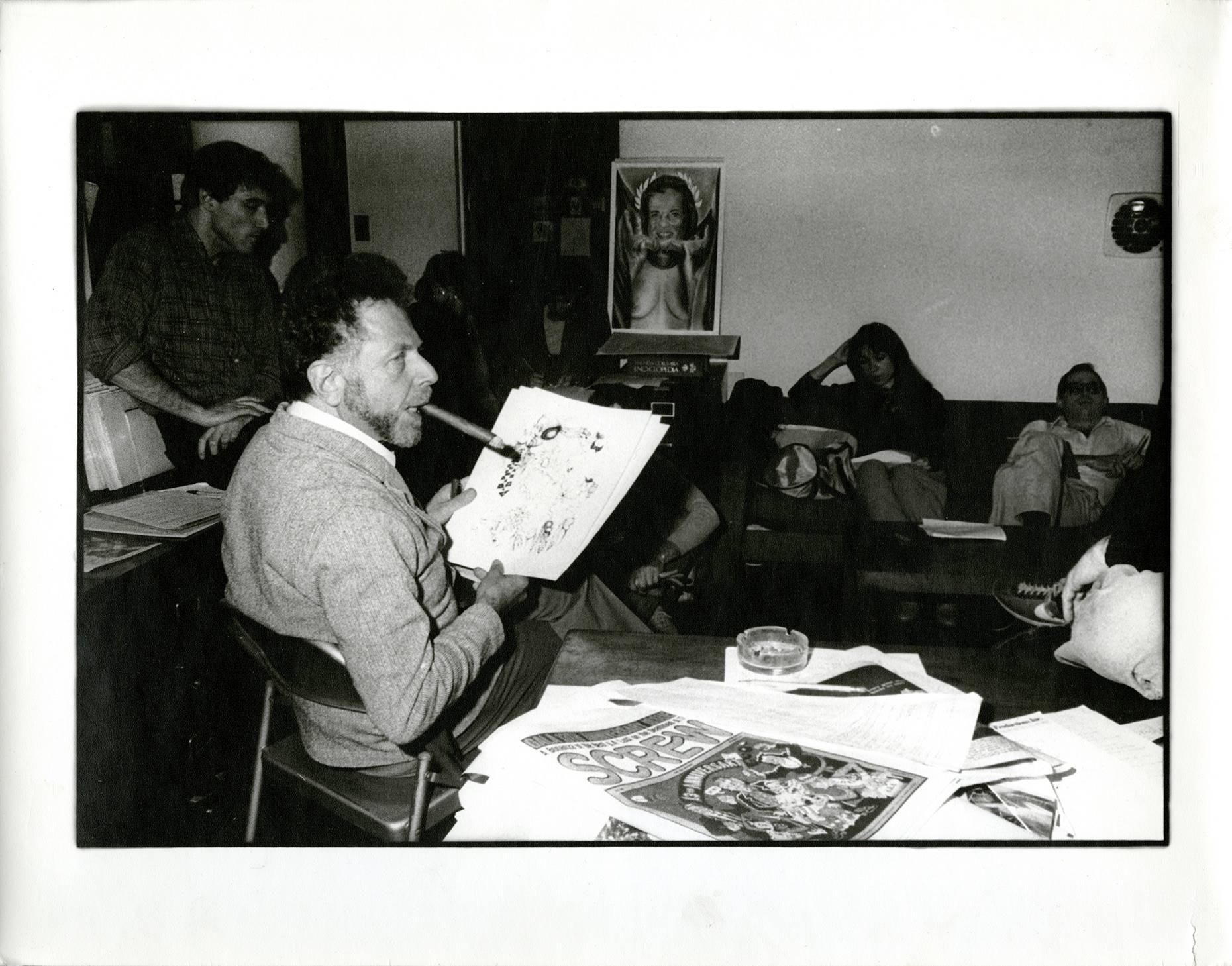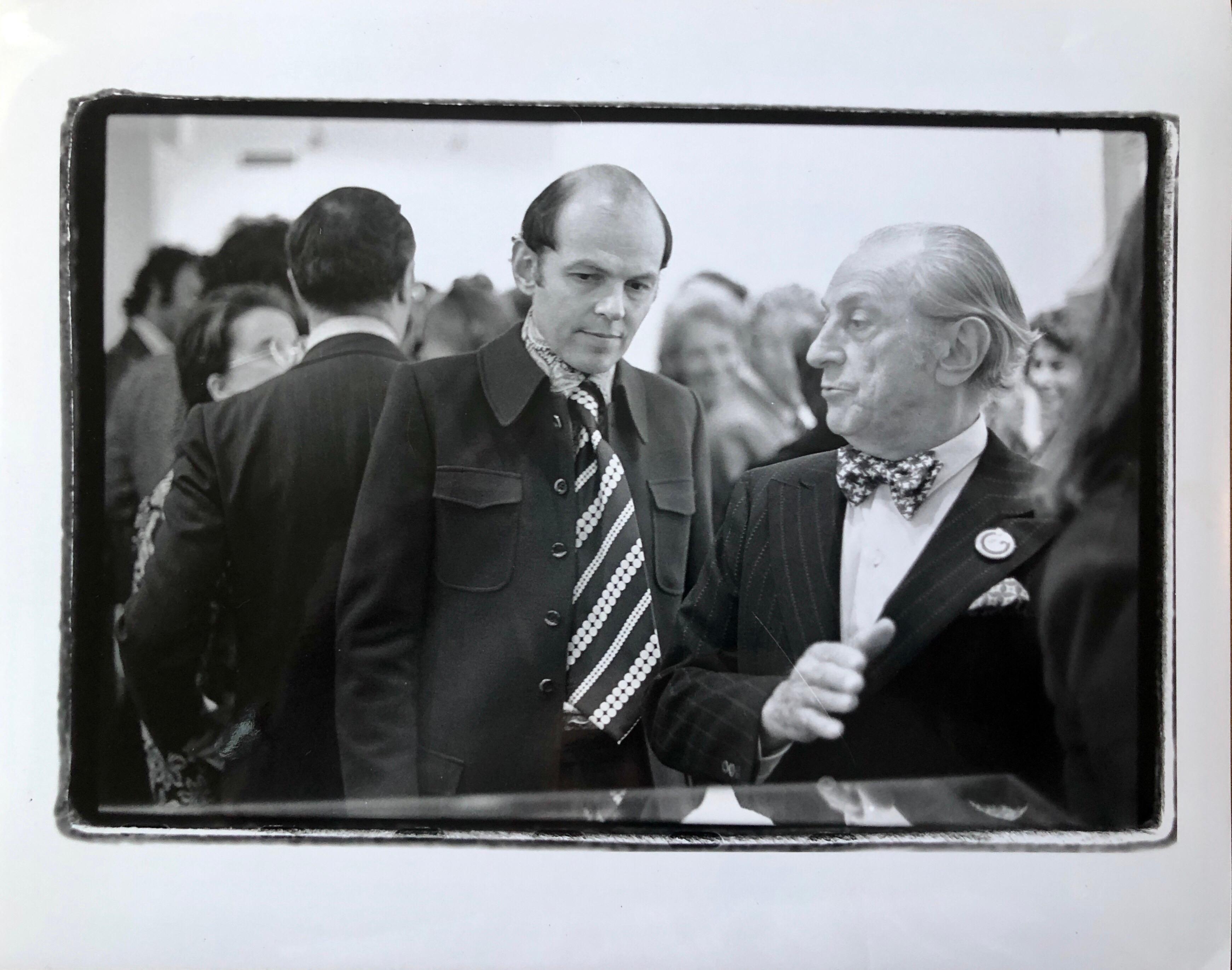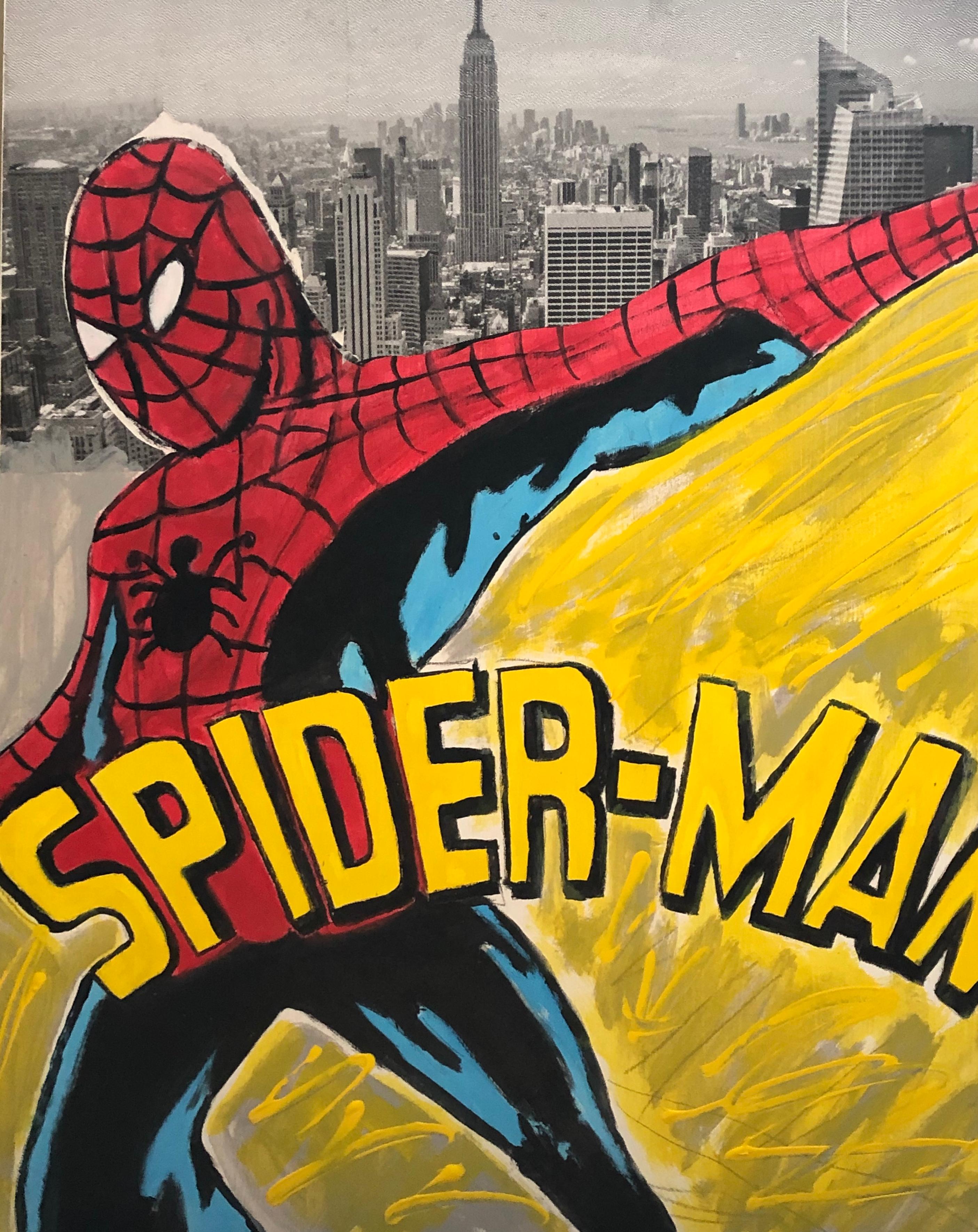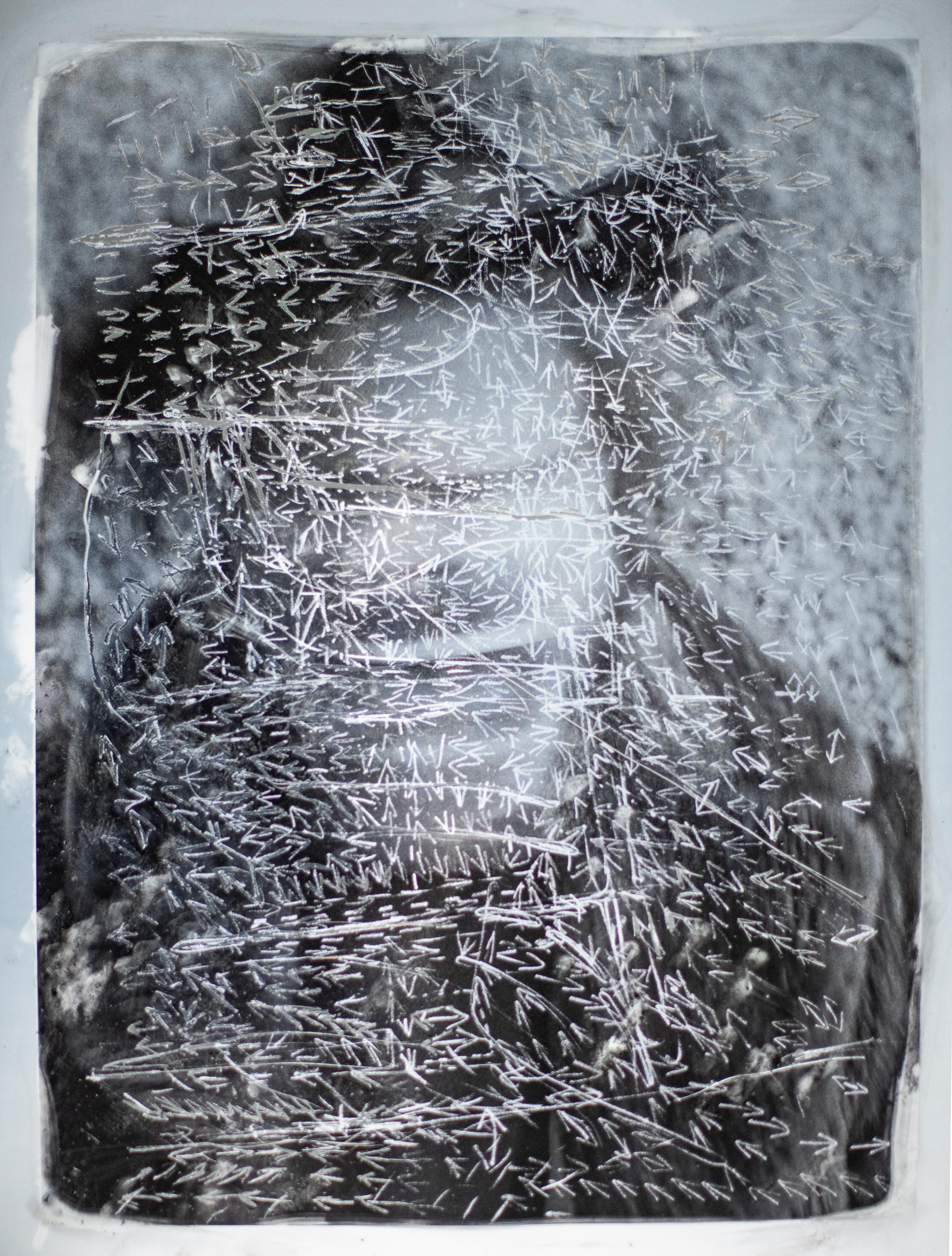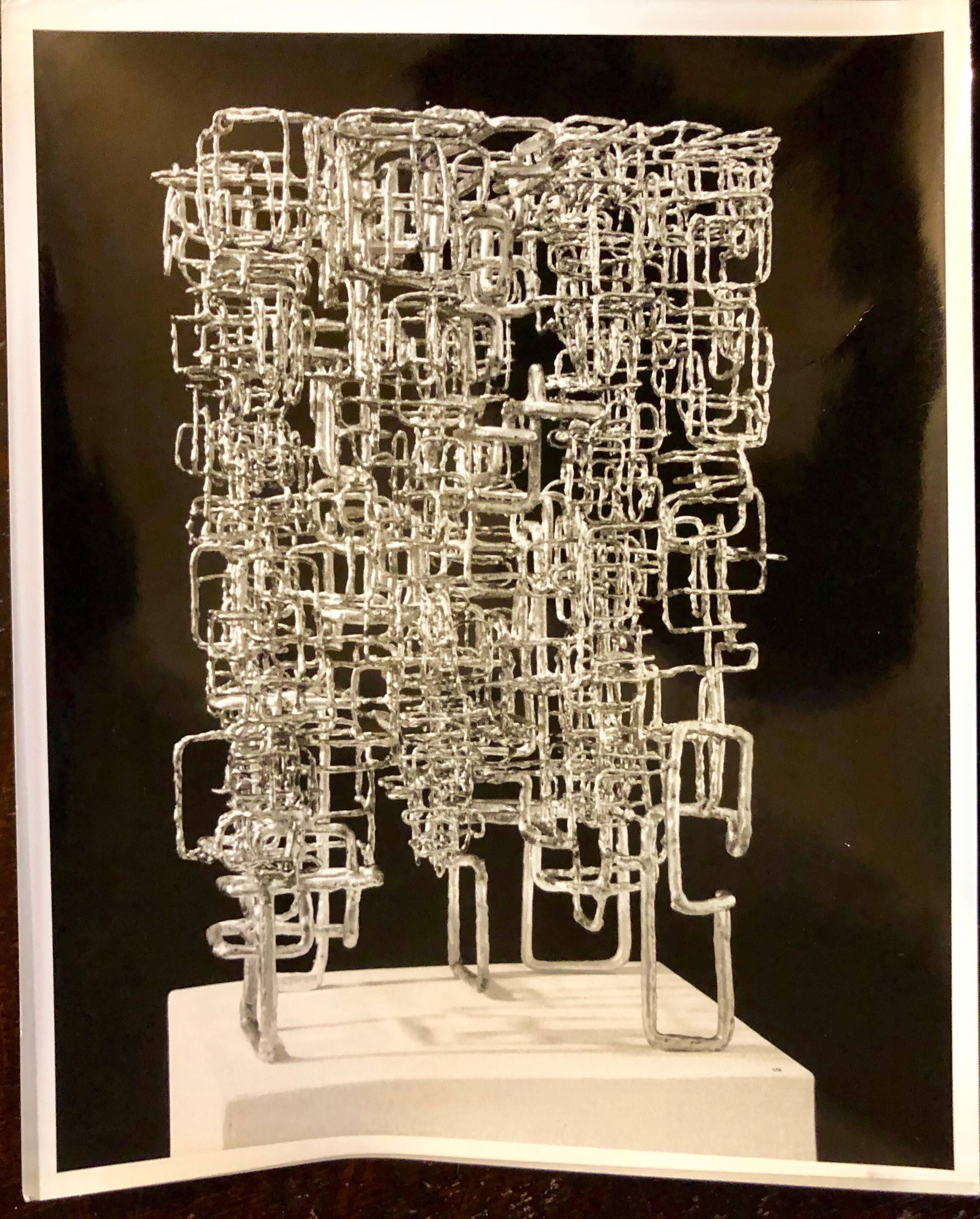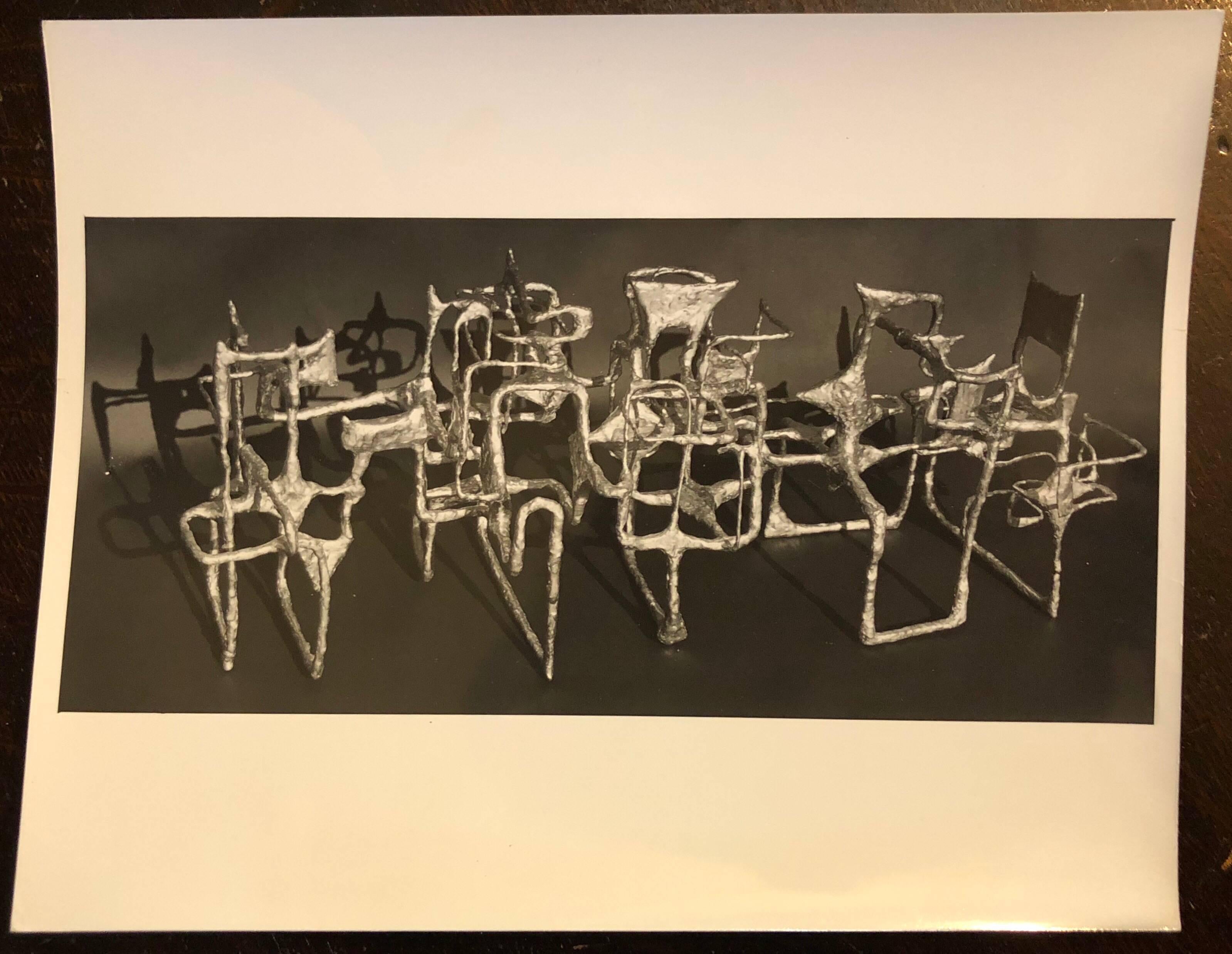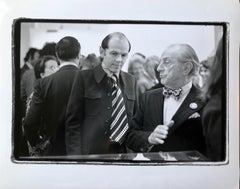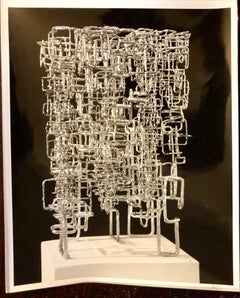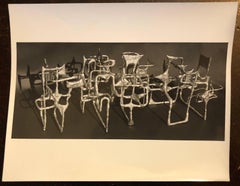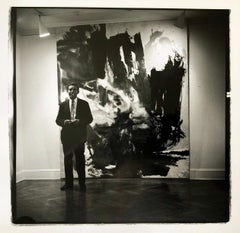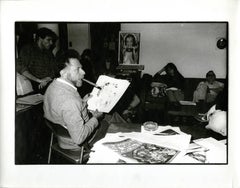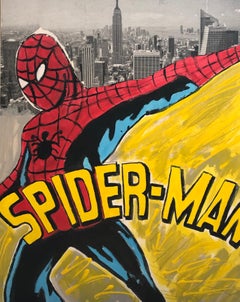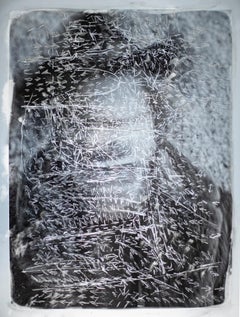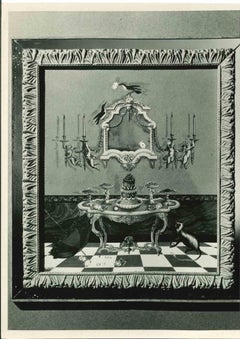Items Similar to Vintage Silver Gelatin Photograph Marvel Comic Book, Amazing Spider Man Pop Art
Want more images or videos?
Request additional images or videos from the seller
1 of 7
UnknownVintage Silver Gelatin Photograph Marvel Comic Book, Amazing Spider Man Pop Art
$950
£726.33
€836.58
CA$1,331.24
A$1,486.21
CHF 778.75
MX$18,192.62
NOK 9,890.13
SEK 9,325.13
DKK 6,243.49
About the Item
This is a vintage silver gelatin photo of either Stan Lee or John Romita (I believe it is Romita but I am not sure) overlayed with a comic strip in a surrealist style.
John Romita is an American comic-book artist best known for his work on Marvel Comics' The Amazing Spider-Man and for co-creating the character The Punisher. He was inducted into the Will Eisner Comic Book Hall of Fame in 2002. He graduated from Manhattan's School of Industrial Art in 1947, having attended for three years after spending ninth grade at a Brooklyn junior high school Among his instructors were book illustrator Howard Simon and magazine illustrator Ben Clements, and his influences included comics artists Noel Sickles, Roy Crane, Milton Caniff, and later, Alex Toth and Carmine Infantino, as well as commercial illustrators Jon Whitcomb, Coby Whitmore, and Al Parker.
Romita entered the comics industry in 1949 on the series Famous Funnies. "Steven Douglas up there was a benefactor to all young artists", Romita recalled. "The first story he gave me was a love story. It was terrible. All the women looked like emaciated men and he bought it, never criticized, and told me to keep working. He paid me two hundred dollars for it and never published it — and rightfully so".
Romita was working at the New York City company Forbes Lithograph in 1949, earning $30 a week, when comic-book inker Lester Zakarin, a friend from high school whom he ran into on a subway train, offered him either $17 or $20 a page to pencil a 10-page story for him as uncredited ghost artist. "I thought, this is ridiculous! In two pages I can make more money than I usually make all week! So I ghosted it and then kept on ghosting for him", Romita recalled. "I think it was a 1920s mobster crime story". The work was for Marvel's 1940s forerunner, Timely Comics, which helped give Romita an opportunity to meet editor-in-chief and art director Stan Lee. Romita ghost-penciled for Zakarin on Trojan Comics' Crime-Smashers and other titles, eventually signing some "Zakarin and Romita".
Romita went on to draw a wide variety of horror comics, war comics, romance comics and other genres for Atlas. His most prominent work for the company was the short-lived 1950s revival of Timely's hit character Captain America, in Young Men #24–28 (Dec. 1953 – July 1954) and Captain America #76–78 (May–Sept. 1954).[21] Additionally, Romita would render one of his first original characters, M-11 the Human Robot, in a five-page standalone science-fiction story in Menace #11 (May 1954). While not envisioned as an ongoing character, M-11 was resurrected decades later as a member of the super-hero team Agents of Atlas.
He was the primary artist for one of the first series with a black star, "Waku, Prince of the Bantu" — created by writer Don Rico and artist Ogden Whitney in the omnibus title Jungle Tales #1 (Sept. 1954). The ongoing short feature starred an African chieftain in Africa, with no regularly featured Caucasian characters. Romita succeeded Whitney with issue #2 (Nov. 1954).
In the mid-1950s, while continuing to freelance for Atlas, Romita did uncredited work for DC Comics before transitioning to work for DC exclusively in 1958.
"I was following the DC [house] style", he recalled in 2002. "Frequently they had another artist do the first page of my stories. Eventually I became their romance cover artist". He would "swipe"—an artists' term for using existing work as models, a common practice among novices—from movie stills and from the Milton Caniff comic strip Terry and the Pirates. Bernard Sachs and Sy Barry inked some of Romita's romance work, but "by the late '50s and early '60s, I was inking my own stuff".
Romita played a major role in defining the look of Marvel Comics and in designing new characters. Among the characters he designed or helped design are the Punisher, Wolverine, Luke Cage, Bullseye, Tigra, and Brother Voodoo. In 1976, Romita did uncredited art corrections on the large-format, first DC/Marvel intercompany crossover, Superman vs. the Amazing Spider-Man, over the pencils of Ross Andru. Later that same year, Romita inked Jack Kirby's pencil work on Captain America's Bicentennial Battles, a one-shot story published in an oversized treasury format.
A Romita image of Spider-Man and a Hulk image penciled by Rich Buckler and inked by Romita were among the "Marvel Super Heroes" set of commemorative stamps issued by the U.S. Postal Service.
- Dimensions:Height: 14 in (35.56 cm)Width: 10.25 in (26.04 cm)
- Medium:
- Movement & Style:
- Period:
- Condition:minor wear, minor creases.
- Gallery Location:Surfside, FL
- Reference Number:1stDibs: LU38213242412
About the Seller
4.9
Platinum Seller
Premium sellers with a 4.7+ rating and 24-hour response times
Established in 1995
1stDibs seller since 2014
1,786 sales on 1stDibs
Typical response time: <1 hour
- ShippingRetrieving quote...Shipping from: Surfside, FL
- Return Policy
Authenticity Guarantee
In the unlikely event there’s an issue with an item’s authenticity, contact us within 1 year for a full refund. DetailsMoney-Back Guarantee
If your item is not as described, is damaged in transit, or does not arrive, contact us within 7 days for a full refund. Details24-Hour Cancellation
You have a 24-hour grace period in which to reconsider your purchase, with no questions asked.Vetted Professional Sellers
Our world-class sellers must adhere to strict standards for service and quality, maintaining the integrity of our listings.Price-Match Guarantee
If you find that a seller listed the same item for a lower price elsewhere, we’ll match it.Trusted Global Delivery
Our best-in-class carrier network provides specialized shipping options worldwide, including custom delivery.More From This Seller
View AllVintage Print Silver Gelatin Signed Photograph Sidney Janis, Conrad Janis, NYC
By Fred McDarrah
Located in Surfside, FL
signed in ink and with photographer stamp verso and hand written title.
Sidney Janis (July 8, 1896 – November 23, 1989) was a wealthy clothing manufacturer and art collector who ope...
Category
1960s American Modern Black and White Photography
Materials
Black and White, Silver Gelatin
Vintage Silver Gelatin Photo of Ibram Lassaw Modernist Sculpture (Photograph)
Located in Surfside, FL
This is from the photogrpaher John A. Ferrari he shot work for Eva Hesse, Robert Mangold, Ronald Bladen and Sol Lewitt. It bears his stamp and label from Zabriskie Gallery.
This is for the original vintage photograph. I believe the inscription is in the hand of Ibram Lassaw some also bear the photographers stamp.
Lassaw was born in Alexandria, Egypt, of Russian Jewish émigré parents, he went to the U.S. in 1921. His family settled in Brooklyn, New York. He became a US citizen in 1928. He first studied sculpture in 1926 at the Clay Club and later at the Beaux-Arts Institute of Design in New York. He made abstract paintings and drawings influenced by Kandinsky, Sophie Tauber Arp...
Category
1960s Abstract Expressionist Abstract Photography
Materials
Silver Gelatin
Vintage Silver Gelatin Photo of Ibram Lassaw Modernist Sculpture (Photograph)
By John Reed
Located in Surfside, FL
Galaxy in Ursa Major with Zabriskie Gallery stamp and Ibram Laassaw stamp verso.
The Photographer is John Reed. An East Hampton Photographer who shot Jackson Pollock, Lee Krasner, Larry Rivers, Philip Guston, Conrad Marca-Relli, Syd Solomon, and James Brooks amongst other art luminaries.
This is for the original vintage photograph. I believe the inscription is in the hand of Ibram Lassaw some also bear the photographers stamp.
Lassaw was born in Alexandria, Egypt, of Russian Jewish émigré parents, he went to the U.S. in 1921. His family settled in Brooklyn, New York. He became a US citizen in 1928. He first studied sculpture in 1926 at the Clay Club and later at the Beaux-Arts Institute of Design in New York. He made abstract paintings and drawings influenced by Kandinsky, Sophie Tauber Arp...
Category
1970s Abstract Expressionist Abstract Photography
Materials
Silver Gelatin
Vintage Print Silver Gelatin Signed Photograph Friedl Dzubas New York Artist
By Fred McDarrah
Located in Surfside, FL
This is a photo of Friedl Dzubas (Abstract Expressionist) at Castelli Gallery, signed in ink and with photographer stamp verso and hand written title..
Over a 50-year span, McDarra...
Category
1950s American Modern Black and White Photography
Materials
Black and White, Silver Gelatin
Vintage Silver Gelatin Print Photograph Marcus Leatherdale Shrouded Figure Photo
Located in Surfside, FL
Marcus Leatherdale (1952 - 2022)
Silver gelatin print with copper leaf mount
1987
Titled: High Priest. From the Demigod series.
Hand signed and dated and bears artist studio stamp verso.
Provenance: Greathouse Gallery (with label & information verso)
Edition: 1 of 10.
Dimensions mage measures 12" x 5", total measurements are 24" x 13"
Marcus Leatherdale was a Canadian portrait photographer.
Marcus Andrew Leatherdale was born on 18 September 1952, in Montreal, Canada, to Jack Leatherdale, a veterinarian, and Grace Leatherdale, a homemaker. He attended the San Francisco Art Institute.
Leatherdale arrived in New York City in 1978, where he attended the School of Visual Arts. started his career in New York City during the early eighties, setting up a studio on Grand Street.
Leatherdale first served as Robert Mapplethorpe office manager for a while and was photographed in the nude by the master, grabbing a rope with his right hand and holding a rabbit in his left.
Thereafter he worked as an assistant curator to Sam Wagstaff. He soon became a darling of the then vibrant club scene and the fashionable media: Interview, Details, The New Yorker, Vanity Fair, and Elle Decor presented his work. Later on he was featured in artsy publications as Artforum, Art News, and Art in America. Leatherdale was the Cecil Beaton of downtown New York,
He photographed a not-yet-famous club kid named Madonna in her ripped jeans and his denim vest. The performance artist Leigh Bowery was majestic in a tinseled mask, a corset and a merkin. Andy Warhol was a Hamlet in a black turtleneck. Susanne Bartsch, the nightlife impressaria, was a towering presence in red leather. He documented the New York City lifestyle, the extraordinary people of Danceteria and Club 57 where he staged his first exhibits in 1980. Leatherdale was an acute observer of the New York City of the nineteen eighties. His models were the unknown but exceptional ones – like Larissa, Claudia Summers or Ruby Zebra – or well known artists – like Madonna, Keith Haring, Andy Warhol, Winston Tong and Divine, Trisha Brown, Lisa Lyon, Andrée Putman, Kathy Acker and Sydney Biddle Barrows, otherwise known as the Mayflower Madam, Jodie Foster, and fellow photographer John Dugdale. He Married Claudia Summers, theirs was not a traditional marriage, but they were best friends, and he was Canadian, so it made life easier if they wed. His boyfriend for a time was Robert Mapplethorpe, whose photography studio Mr. Leatherdale also managed. He and Mapplethorpe were a striking pair, dressed like twins in leather and denim, their faces as if painted by Caravaggio, and they often photographed each other.
Jean-Michel Basquiat was often hanging out there, playing his bongo drums; so were friends like Cookie Mueller, the doomed, gimlet-eyed author and Details magazine contributor who was for a time Mapplethorpe’s and Ms. Summers’ drug dealer, and Kathy Acker, the performance artist and novelist. For quite a while Leatherdale remained in Mapplethorpe's shadow, but was soon discovered as a creative force in his own right by Christian Michelides, the founder of Molotov Art Gallery in Vienna. Leatherdale flew to Vienna, presented his work there and was acclaimed by public and press.
This international recognition paved his way to museums and permanent collections such as the Rheinisches Landesmuseum Bonn, the Art Institute of Chicago, the Australian National Gallery in Canberra, the London Museum in London, Ontario, and Austria's Albertina. He was included in the MoMA exhibit New York/New Wave along with Kenny Scharf, William Burroughs, John Crash Matos, Larry Clark, Nan Goldin, Lawrence Weiner and Stephen Sprouse. Above all, his arresting portraits of New York City celebrities in the series Hidden Identities aroused long-lasting interest amongst curators and collectors.
In 1993, Leatherdale began spending half of each year in India's holy city of Banaras. Based in an ancient house in the centre of the old city, he began photographing the diverse and remarkable people there, from the holy men to celebrities, from royalty to tribals, carefully negotiating his way among some of India's most elusive figures to make his portraits. From the outset, his intention was to pay homage to the timeless spirit of India through a highly specific portrayal of its individuals. His pictures include princesses and boatmen, movie stars and circus performers, and street beggars and bishops, mothers and children in traditional garb. Leatherdale explored how essentially unaffected much of the country was by the passage of time; and it has been remarked upon that this approach is distinctly post-colonial. In 1999, Leatherdale relocated to Chotanagpur (Jharkhand) where he focusing upon the Adivasis. Later Serra da Estrela in the mountains of central Portugal became his second home base.
Leatherdale's matte printing techniques, which adapt nineteenth-century processes and employ half black, half sepia colorations, reinforce the timelessness of his subjects. Tones and matte surfaces effectively differentiate his portraits from the easy slickness of fashion photography.
In 2019, Mr. Leatherdale compiled his work from 80s in a book entitled “Out of the Shadows”, written with Claudia Summers.
During his time in New York City, he dated Robert Mapplethorpe, whose photography studio Leatherdale managed. His partner of two decades, Jorge Serio, died in July 2021
Major exhibitions
1980 Urban Women, Club 57, NYC
1980 Danceteria, NYC
1981 Stilvende, NYC
1982 The Clock Tower, PS1, NYC
1982 544 Natoma Gallery, San Francisco
1982 Eiko And Koma, Stilvende, NYC
1983 Form And Function Gallery, Atlanta
1983 Galerie in der GGK Wien, Vienna, Austria
1983 The Ring, Vienna (organized by Molotov)
1983 London Regional Art Gallery, London, Ontario, Canada
1984 Performance, Greathouse Gallery, NYC
1984 Social Segments, Grey Art Gallery, NYU
1984 Rheinisches Landesmuseum, Bonn
1985 Ritual, Greathouse Gallery, NYC
1985 Artinzer, Munich
1985 Leatherdale/Noguchi, Gallery 291, Atlanta
1985 Paul Cava Gallery, Philadelphia
1986 Poison Ivy, Greathouse Gallery, NYC
1986 Wessel O’Connor Gallery, Rome
1986 Hidden Identities, Michael Todd Gallery, Palladium, NYC
1987 Demigods, Greathouse Gallery, NYC
1987 Collier Gallery, Scottsdale, Arizona
1987 Tunnel Gallery, NYC
1988 Claus Runkel Fine Art Ltd., London, UK
1988 Madison Art Center, Madison
1989 Wessel-O’Connor Gallery, NYC
1989 Summer Night Festival, Onikoube, Sendai
1990 Bent Sikkema Fine Art, NYC
1990 Fahey-Klein Gallery, Los Angeles
1990 Faye Gold Gallery, Atlanta
1990 Mayan Theatre, Los Angeles
1991 Runkel Hue-Williams Gallery, London
1991 Galerie Michael Neumann, Düsseldorf
1991 Arthur Rogers Gallery, New Orleans
1992 Arthur Rogers, NYC
1992 Galerie Del Conte, Milwaukee
1993 Galerie Bardamu, NYC
1996 Fayf Gold Gallery, Atlanta
1996, 1997, 1998, 1999 Bridgewater/Lustberg, NYC
1998 Rai Krishna Das...
Category
1980s 85 New Wave Black and White Photography
Materials
Silver Gelatin
Ivan Karp Sherman Drexler Vintage Silver Gelatin Photograph New York City Photo
By Fred W. McDarrah
Located in Surfside, FL
Ivan Karp Sherman Drexler
Ivan C. Karp (June 4, 1926 – June 28, 2012) was an American art dealer, gallerist and author instrumental in the emergence of pop art in the 1960s.
Karp ...
Category
20th Century Black and White Photography
Materials
Silver Gelatin
You May Also Like
Fernando Natalici Al Goldstein New York 1979
By Fernando Natalici
Located in NEW YORK, NY
Al Goldstein by heralded New York underground photographer Fernando Natalici
Silver Gelatin Print, c.1979.
11x14 inches.
Hand signed & dated on the verso from an edition of 2.
Some minor residue or fading to edges and minor signs of handling; otherwise in very good condition for its age.
Al Goldstein:
If Hugh Hefner strove to put a sleek, air-brushed image on sexual freedom in the 1960s, rival publisher Al Goldstein was the polar opposite. Unabashedly abrasive and foul-mouthed, the cigar-chomping, a larger than life Goldstein called his explicit magazine Screw.
When he co-founded Screw in 1968, the American legal system was embroiled in a battle over what constitutes obscenity. Goldstein never envisioned himself as a champion of free speech, but fought for what he said were his own prurient interests.
The porn magazine's scathing, scatological editorials railed against religious leaders and the government for justifying war while imprisoning erotic magazine...
Category
1970s Pop Art Black and White Photography
Materials
Silver Gelatin
Spiderman
By David Morico
Located in New York, NY
Nostalgic mixed media on wood. Spiderman. Pop art genre. NYC in the background.
About the artist: David's paintings have a build-up of layers using different mixed mediums s...
Category
2010s Pop Art Mixed Media
Materials
Mixed Media
Directive Forces. Mixed media fashion portrait on a Black and white photography
By Hunter & Gatti
Located in Miami Beach, FL
The “visible” spectrum, is probably the most well-known of human sensory limitations, as the human #eye is only capable of perceiving light at wavelengths between 390 and 750 nanometers. Of course, calling it the “visible” spectrum is a bit of a misnomer, as plenty of animals are capable of perceiving light with frequencies outside this relatively narrow band of electromagnetic radiation. Using infrared black and white...
Category
2010s Abstract Impressionist Mixed Media
Materials
Metal
Decoupage - American Vintage Photograph - Mid 20th Century
Located in Roma, IT
Decoupage - American Vintage Photograph is an original black and white photograph realized in the U.S in the Mid-20th Century in a series on American life in the 20th Century.
With ...
Category
Mid-20th Century Modern Figurative Photography
Materials
Photographic Paper
Vintage American Silver Gelatin Photo
By Shirley Carter Burden
Located in Houston, TX
Original pencil signed silver gelatin photograph of a workman among building debris by Shirley Carter Burden, 1953. Signed " S.C. Burden" in pencil lower right.
From a personal por...
Category
1950s Other Art Style Black and White Photography
Materials
Photographic Paper
Pepe Contino 1978 original photoengraving signed limited edition pop art print 3
Located in Miami, FL
Jose "Pepe" Contino (Cuba, 1933)
'Untitled (from Porfolio Grabados Cubanos)', 1978
silkscreen on paper Canson 320 g.
17.6 x 23.6 in. (44.6 x 59.8 cm.)
Edition of 200
ID: CON-303
Hand...
Category
1970s Modern Prints and Multiples
Materials
Screen, Photogravure
More Ways To Browse
Industrial Art Photos
Vintage Comic Art
African Art Unknown Artist
Star Wars Vintage Art
Large Black And White Lithographs
Bicentennial Art
Vintage Jungle Art
Star Wars Pop Art
Vintage Comic Strip
John Douglas
Vintage Science Fiction Art
Bullseye Art
John Douglas Artist
Used Kirby
Original Comic Strip Art
1920s Silver Gelatin Photographs
Ben Simon
The Jungle Book
